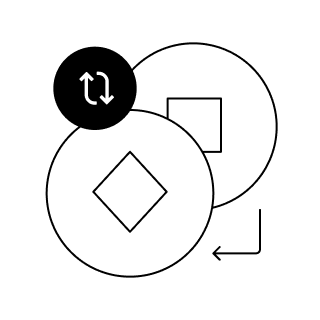What’s Worldcoin (WLD)? How can I buy it?
What is Worldcoin?
Worldcoin is a crypto project and digital identity protocol that aims to build a global network of verified humans and a universal financial layer. Co-founded by Sam Altman (OpenAI), Alex Blania, and Max Novendstern, Worldcoin’s core idea is to provide a proof-of-personhood identity (World ID) to anyone in the world and pair it with a native token (WLD) to bootstrap adoption. The project proposes that as AI accelerates and the internet becomes increasingly saturated with bots, a privacy-preserving way to prove you are human becomes foundational infrastructure—both for on-chain applications and the broader internet.
Worldcoin’s stack includes:
- World ID: A decentralized, self-custodial identity primitive based on zero-knowledge proofs (ZKPs) to verify personhood without exposing personal data.
- The Orb: A custom biometric imaging device that scans a user’s iris to create a unique cryptographic identifier used only to prevent duplicate registrations.
- World App: A wallet application developed by Tools for Humanity (TFH) that enables users to manage their World ID credentials and interact with the Worldcoin token and supported assets.
- WLD token: A utility and governance-minded token on Ethereum (with significant activity on layer-2 networks like Optimism) designed to incentivize network participation and facilitate on-chain governance over time.
The long-term vision is twofold: enable Sybil-resistant online systems (such as fair airdrops, one-person-one-vote governance, spam-resistant social networks) and foster a more inclusive financial system by giving everyone access to a crypto wallet and digital identity, potentially enabling direct distributions or universal basic income-like experiments.
Note: Worldcoin has attracted significant attention—both positive and critical—due to its global biometric enrollment campaign, privacy implications, and regulatory scrutiny in multiple jurisdictions. Its design emphasizes privacy-preserving cryptography, but the collection and handling of biometric data remain a focal point of public debate and oversight.
How does Worldcoin work? The tech that powers it
Worldcoin combines biometrics, cryptography, and blockchain to achieve proof of personhood while minimizing data exposure.
Key components:
- Enrollment with the Orb
- The Orb captures a high-resolution image of a user’s iris.
- A one-way iris code (an iris hash) is generated locally to create a unique identifier (IrisCode or IrisHash). According to Worldcoin’s technical documentation, the biometric image is deleted by default after creating the code, unless a user opts in to data retention to help improve the system.
- The uniqueness check ensures each person can register only once, preventing Sybil attacks (multiple identities controlled by the same entity).
- The output is a World ID credential anchored on-chain, not the biometric data itself.
- World ID and zero-knowledge proofs
- World ID functions as a decentralized identifier (DID) and uses zero-knowledge proofs (ZKPs) to let users prove to apps that they are verified humans without revealing their identity or biometric data.
- The system leverages privacy-preserving protocols so that apps receive a simple attestation (is-human) rather than personal details.
- World ID credentials are designed to be self-custodial and portable. Users can hold their credentials in compatible wallets and selectively disclose proofs to different services.
- On-chain architecture
- Worldcoin operates primarily on Ethereum, with scalability facilitated by layer-2 solutions (initially Optimism’s OP Stack). This reduces fees and supports higher throughput for verifications and token interactions.
- Smart contracts manage the registry of verified World IDs, token distribution mechanisms, and—over time—governance processes.
- Rate limits and nullifiers: ZK nullifiers help prevent multiple claims or abuses while keeping users anonymous. Apps can specify per-app nullifiers for privacy-preserving uniqueness per service.
- Token mechanics (WLD)
- WLD is an ERC-20 token designed to incentivize adoption and align stakeholders.
- Distribution includes grants to new verified users in supported regions, ecosystem development, and allocations to contributors and investors, subject to vesting schedules.
- The token may play a growing role in protocol governance, including parameters around identity issuance, privacy settings, and ecosystem funding.
- Dev integrations and use cases
- Apps can integrate World ID to gate services, enforce one-person-one-vote polls, reduce bot spam in social platforms, and apportion benefits (airdrops, rewards) on a per-human basis.
- The World App supports stablecoin payments, transfers, and World ID verifications, aiming to serve users in regions with limited access to traditional banking.
Security and privacy considerations:
- Biometric hashing and ZKPs are intended to ensure that even if on-chain data is public, it does not reveal personal information.
- The Orb is a specialized hardware device; hardware security and supply chain integrity are critical. Worldcoin states devices undergo anti-tamper measures and audits.
- Data handling has been scrutinized by regulators. Worldcoin emphasizes on-device processing and default deletion of raw biometrics, but local compliance requirements vary by country.
What makes Worldcoin unique?
- Global proof-of-personhood at scale: Worldcoin is one of the most ambitious attempts to establish a universally accessible, Sybil-resistant human identity layer, which could become foundational for AI-era applications, public goods funding, and digital governance.
- Privacy-first design using ZKPs: Unlike KYC approaches that reveal personal data, World ID focuses on anonymous verification, aiming to prove uniqueness without identity disclosure.
- Hardware-enabled uniqueness: The Orb’s iris-based uniqueness check—controversial yet effective—addresses a core challenge in decentralized identity: preventing duplicate registrations globally without centralized identity databases.
- Human-centric rate limits: ZK nullifiers let apps enforce one-person limits without tracking users across services, preserving privacy.
- Ecosystem potential: If widely adopted, World ID could enable new economic models, including fair drops, democratic governance, and bot-resistant social protocols. The WLD token aligns incentives for users, developers, and validators of the identity layer.
Worldcoin price history and value: A comprehensive overview
Note: Crypto prices are highly volatile. For the latest price and market cap, consult reputable aggregators such as CoinGecko, CoinMarketCap, Messari, or The Block.
High-level historical context:
- Launch and distribution: WLD launched in July 2023 alongside broader public enrollment campaigns. Listings on major exchanges drove early liquidity and volatility.
- Macro and AI narrative: Interest in AI-linked crypto projects has influenced WLD’s market cycles. Periods of accelerated AI adoption and media attention around Sam Altman and OpenAI have often coincided with spikes in WLD trading volumes.
- Regulatory headlines: Investigations and pauses in certain countries regarding data protection and biometric collection have introduced event risk, affecting price sentiment.
- Ecosystem development: Technical milestones (World ID improvements, expansion to new regions, integrations with L2s, SDK releases) and monthly user verification numbers have contributed to narrative-driven rallies and pullbacks.
Valuation drivers to monitor:
- User growth: Number of verified World IDs and active wallets.
- Developer adoption: Integrations of World ID across web3 and web2 apps.
- Token supply dynamics: Circulating supply growth, unlock schedules, and emissions policy.
- Governance roadmap: Clarity on decentralization, community control, and token utility beyond distribution.
- Regulatory progress: Compliance outcomes in key markets (EU, US, LATAM, Africa, and Asia).
Is now a good time to invest in Worldcoin?
This is not financial advice, but here are the core considerations an informed investor might weigh:
Bullish factors:
- Strong narrative fit: In an AI-driven world, verifiable humanity is an addressable need. A credible, privacy-preserving solution could see broad adoption.
- Network effects: If World ID becomes a widely accepted standard, barriers to entry rise for competitors, potentially reinforcing WLD’s role in governance and incentives.
- Technical moat: The combination of custom hardware, ZK cryptography, and on-chain architecture is nontrivial to replicate.
- Backing and execution: High-profile founders, significant funding, and rapid shipping cadence may support continued ecosystem growth.
Bearish and risk factors:
- Regulatory uncertainty: Biometric data collection faces stringent rules. Suspensions, fines, or restrictions in key jurisdictions could limit growth.
- Adoption risk: Convincing developers and users to depend on a new identity layer—especially one involving in-person biometric enrollment—is challenging.
- Privacy and perception: Despite ZK design, public skepticism over biometrics remains high. Any data mishandling incident would be severely damaging.
- Token economics: Monitor circulating supply increases and unlocks. If demand does not keep pace with emissions, price pressure may result.
- Competition: Alternative proof-of-personhood projects (e.g., social-graph attestations, CAPTCHA-like protocols, phone-based verifications) could win on convenience or compliance.
Practical approach:
- Do your own research (DYOR): Read the Worldcoin whitepaper and technical docs, and review independent analyses from Messari, Electric Capital, a16z crypto, and academic papers on proof-of-personhood and ZK identity.
- Position sizing and risk management: Treat WLD as a high-risk asset. Consider dollar-cost averaging and setting clear thesis checkpoints (user growth, integrations, regulatory milestones).
- Diversification: Balance exposure with other sectors of crypto and traditional assets.
- Stay updated: Follow official Worldcoin communications, GitHub repositories, and third-party security audits. Track regulatory developments in your country.
Sources and reference points for further reading:
- Worldcoin docs and whitepaper (Worldcoin.org, docs.worldcoin.org)
- Ethereum and Optimism technical documentation for L2 architecture
- Messari and CoinGecko profiles and research notes on Worldcoin
- Data protection authority statements in jurisdictions reviewing Worldcoin’s operations
- Academic literature on zero-knowledge proofs and decentralized identifiers (DIDs)
Discover the different ways to buy crypto in the UAE
Create an OKX account
Get verified
Start a trade
Enter an amount
Choose your payment method
Confirm your order
All done
Create an OKX account
Get verified
Start a trade
If Worldcoin isn’t available in the dropdown, purchase any of the available tokens and convert it to WLD.
Place a buy order
Complete your purchase
Receive your WLD
All done
Get the OKX app or Wallet extension
Set up your wallet
Fund your wallet
Find your next purchase
Note:
Tokens with the same symbol can exist on multiple networks or may be forged. Always double-check the contract address and blockchain to avoid interacting with the wrong tokens.
Trade your crypto on OKX DEX
Choose the token you’re paying with (e.g., USDT, ETH, or BNB), enter your desired trading amount, and adjust slippage if needed. Then, confirm and authorize the transaction in your OKX Wallet.
Limit order (optional):
If you’d prefer to set a specific price for your crypto, you can place a limit order in Swap mode.
Enter the limit price and trading amount, then place your order.
Receive your crypto
All done

Make informed decisions


How to get Worldcoin for free
See what you can do with your crypto
How to buy Worldcoin (WLD) FAQ
Disclaimer
You are viewing content that has been summarized by AI. Please be aware that the information provided may not be accurate, complete, or up-to-date. This information is not (i) investment advice or an investment recommendation, (ii) an offer, solicitation, or inducement to buy, sell or hold digital assets, or (iii) financial, accounting, legal or tax advice. Digital assets are subject to market volatility, involve a high degree of risk, and can lose value. You should carefully consider whether trading or holding digital assets is suitable for you in light of your financial condition and risk tolerance. Please consult your legal/tax/investment professional for questions about your specific circumstances.














